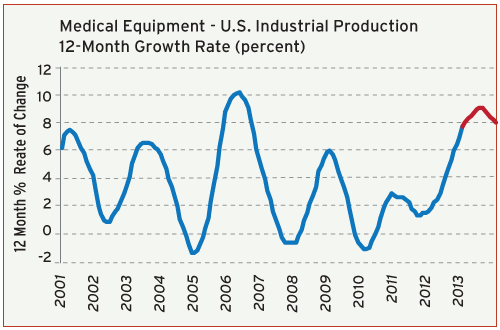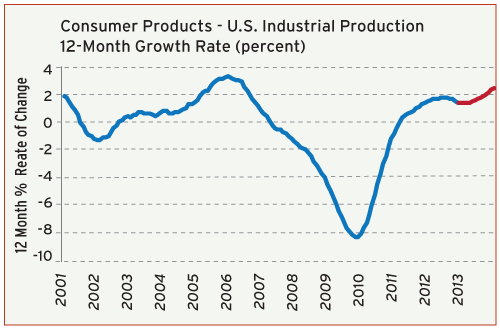Medical & Consumer Products End Market Report 2013
Medical & Consumer Products
Production of Medical Equipment and Supplies Will Rise
After expanding by a hearty 8% in 2012, the total U.S. output of medical equipment and supplies will expand by another 8% in 2013. The market for medical products will be significantly affected for the foreseeable future by the Affordable Care Act (a.k.a. the ACA or Obamacare). It is estimated that the ACA will ultimately generate 30 to 40 million new customers for medical products and services because they will now receive health insurance. Obama says this will result in a savings for taxpayers in the long run, but I suspect this is wrong. I predict that the total amount of money spent on healthcare in this country is going to rise.
For manufacturers of plastics medical products this could be good news. This is because the rapidly rising costs of healthcare will generate demand for products that lower these costs to the insurers. There are several ways that plastics products can achieve these kinds of savings, and most of the savings stem from the fact that plastics products add simplicity to the highly complex problem of keeping Americans healthy.
One method that insurers will utilize to lower healthcare costs is to reduce the amount of time patients spend in the hospital. Thus, many types of medical equipment and supplies will be sold directly to consumers through retail outlets in much the same way that prescription drugs are now. This will also spur demand for new, low-cost devices that monitor and communicate medical information between patients at home and doctors in the hospital.
Another way to contain costs is to reuse or recycle medical supplies. A large percentage of the plastic supplies that are currently sold to healthcare providers are considered disposable. But resins prices are rising, and so are disposal costs. Many of the plastic products can be redesigned, so they can be sterilized and used multiple times, or integrated into the recycling stream.
Output of Consumer Products Will Gradually Improve
Total U.S. production of plastics consumer products will gradually accelerate in 2013. The growth rate in the output of these products slowed to just over 1% in 2012, but our latest forecast calls for growth of over 2% in 2013. This forecast is based on a couple of long-term trends that should keep this segment expanding for several years.
The most important factors that drive overall demand for consumer products are the trends in the residential real estate and construction sectors. Activity levels in these industries were subdued for most of the past five years. But the trends turned the corner in 2012 and are now poised for a more robust recovery. This is good news for all aspects of the American economy, and manufacturers of consumer products will be amongst the largest beneficiaries.
Another factor that is a positive for U.S. suppliers of these products is the accelerating development of the natural gas industry in this country. In the near future most of the plastic resin in this country will be manufactured from natural gas-based derivatives, and this should result in lower resins costs. Cheaper natural gas will also lower the costs of electricity and transportation fuels. Low-cost countries that export consumer goods (i.e. China) will still be major players in the consumer products segment. But due to the decline in overall manufacturing costs in the U.S., the production of many types of these products in the future will stay close to this market, and the trend of increased re-shoring will also continue.
Related Content
How to Improve Your Current Efficiency Rate
An alternative approach to taking on more EDM-intensive work when technology and personnel investment is not an option.
Read MoreOEE Monitoring System Addresses Root Cause of Machine Downtime
Unique sensor and patent-pending algorithm of the Amper machine analytics system measures current draw to quickly and inexpensively inform manufacturers which machines are down and why.
Read MoreThe Role of Social Media in Manufacturing
Charles Daniels CFO of Wepco Plastics shares insights on the role of social media in manufacturing, how to improve the “business” side of a small mold shop and continually developing culture.
Read MoreMMT Chats: Solving Schedule and Capacity Challenges With ERP
For this MMT Chat, my guests hail from Omega Tool of Menomonee Falls, Wisconsin, who share their journey with using enterprise resource planning (ERP)—and their people—to solve their schedule and capacity load monitoring challenges.
Read MoreRead Next
Overall Business Remains Unchanged
Total Mold Business Index for November 2012: 45.8
Read MoreAre You a Moldmaker Considering 3D Printing? Consider the 3D Printing Workshop at NPE2024
Presentations will cover 3D printing for mold tooling, material innovation, product development, bridge production and full-scale, high-volume additive manufacturing.
Read MoreHow to Use Continuing Education to Remain Competitive in Moldmaking
Continued training helps moldmakers make tooling decisions and properly use the latest cutting tool to efficiently machine high-quality molds.
Read More.jpg;maxWidth=970;quality=90)





.jpg;maxWidth=300;quality=90)














